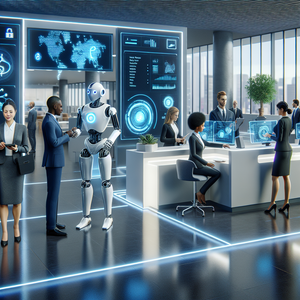The Evolution of a Driver’s Day in 2025

The day begins not with the rumble of a diesel engine, but with the quiet hum of an electric truck. At 6:00 a.m., the driver checks the battery charge of their EV, a vehicle that serves as much more than just a machine for transportation. It’s a high-tech command center on wheels, equipped with an AI-powered logistics app that has meticulously planned the day’s route. This app incorporates real-time traffic, weather conditions, and delivery deadlines into its calculations, ensuring a seamless schedule while suggesting optimal charging stops. Although the route is largely automated, the driver plays a critical role—reviewing the plan, verifying delivery details, and mentally preparing for the day. This collaboration between human intuition and machine precision sets the tone for the hours ahead. As they climb into the sleek, modern cab, the truck’s AI assistant greets them with a voice update: “Good morning! Your first delivery is in 45 minutes. Traffic is clear, and your battery is at 95%—you’re set for the trip.” While technology handles the mechanics of planning, it is the driver’s oversight and readiness that ensure a successful start to the day.
The Road Ahead: Assisted Driving Meets Human Expertise
As the truck cruises along the highway, assisted-driving technologies work in tandem with the driver to create a safer and less taxing journey. Lane-keeping systems, adaptive cruise control, and collision avoidance sensors reduce fatigue and improve safety. However, despite these advancements, the driver remains at the helm, ready to step in during complex or unexpected situations that require judgment and experience. For instance, when encountering a construction zone, the truck’s AI system suggests a detour. However, the driver uses their knowledge of local routes and intuition to determine the best course of action. In this case, the driver decides to take a narrow rural road that the AI system couldn’t fully account for—proving that no algorithm can replace the nuances of human decision-making. This seamless partnership between human expertise and machine efficiency exemplifies the evolving role of a truck driver in 2025.
Breaks: Recharging More Than Batteries
By mid-morning, the driver pulls into a rest area—no longer the noisy, diesel-fueled truck stops of the past, but modern hubs equipped with high-speed EV charging stations. While the truck charges, the driver takes time to recharge themselves, stretching their legs, enjoying a meal, and staying connected through the vehicle’s built-in connectivity hub. These breaks also provide opportunities for communication. While AI systems handle much of the routine updates between drivers and dispatch teams, human interaction remains vital. A quick video call with a dispatcher helps address any changes in delivery priorities or unforeseen delays. This interaction underscores the driver’s evolving role—not just as a transporter, but as an integral part of a collaborative logistics network.
The Human Touch in Customer Interaction
Arriving at the delivery site, the driver faces a challenge that technology alone cannot resolve. The customer’s loading dock is smaller than anticipated, requiring precise maneuvering to unload the cargo safely. Drawing on their skill and experience, the driver successfully navigates the situation, avoiding delays or damage to property. Beyond problem-solving, the driver engages with the customer, delivering a level of service that goes far beyond what an AI system could provide. A friendly conversation, a quick update on the shipment’s condition, and a willingness to accommodate special requests leave a positive impression. Such interactions often solidify long-term business relationships, proving that the human touch remains indispensable in an increasingly automated industry.
Evening: Reflecting on a Day Powered by AI and Humanity
As the day winds down, the driver returns to their home base or a designated rest area. Gone are the days of manually updating paperwork; today, logs are automatically recorded and delivery confirmations are sent electronically. The truck’s AI system provides the driver with a detailed performance report, highlighting battery efficiency, delivery times, and safety metrics. This data not only helps the driver improve but also contributes to the company’s broader efforts to refine operations. Before heading to bed, the driver reflects on the day’s achievements. While technology has undoubtedly made their job easier and safer, the day’s challenges reaffirm the importance of their unique skills. Adapting to unexpected circumstances, building customer relationships, and making real-time decisions are capabilities that no machine can replicate.
The trucking industry of 2025 stands as a powerful example of how technology and humanity can coexist. AI, electric trucks, and advanced logistics systems have ushered in a new era of efficiency and sustainability. However, the heart of the industry remains the driver—an individual whose expertise, adaptability, and interpersonal skills ensure the smooth flow of goods across the country. Despite ongoing advancements, the profession is far from being fully automated. Truck drivers remain indispensable, particularly for last-mile deliveries and complex scenarios where human intuition is paramount. As we look to the future, it’s clear that the evolution of a driver’s day is not about replacing humans with machines, but about empowering them with tools to excel. Technology handles the routine, but drivers provide the creativity, empathy, and judgment that fuel the industry’s success. In this harmonious partnership, the road ahead is bright—one where humans and technology travel together, shaping a sustainable and dynamic future for trucking.
Electric Truck Fleet Technician
Tesla, Nikola Motors, Ryder, FedEx
Responsibilities
Perform maintenance and diagnostics on electric vehicle (EV) systems, including batteries, motors, and power electronics.
Monitor fleet performance using real-time telematics data to proactively identify and address potential issues.
Collaborate with software engineers to troubleshoot AI-driven systems controlling navigation, safety, and logistics.
Required Skills
Expertise in EV technology, including high-voltage systems and charging infrastructure.
Familiarity with diagnostic tools for EVs and software-based systems.
Certifications such as ASE Electric Vehicle Certification or equivalent are highly valued.
AI Logistics Coordinator
DHL, UPS, Amazon Logistics
Responsibilities
Program and monitor AI-powered logistics platforms to optimize delivery routes and schedules.
Analyze real-time data on traffic, weather, and delivery metrics to adjust plans and improve efficiency.
Serve as the point of contact between drivers and AI systems, troubleshooting issues in routing or dispatch.
Required Skills
Strong understanding of AI systems and logistics algorithms (e.g., machine learning for route optimization).
Experience with logistics software like Oracle Transportation Management or SAP TM.
Analytical skills to interpret data and suggest actionable improvements.
Autonomous Vehicle Safety Operator
Waymo, Embark, Aurora Innovation
Responsibilities
Oversee and actively monitor autonomous driving systems during test drives or live operations, ensuring safety and compliance.
Take control of the vehicle in situations where the AI system cannot respond effectively.
Document system performance, identifying areas for improvement in AI decision-making.
Required Skills
Background in driving commercial vehicles, with certifications like a CDL (Commercial Driver’s License).
Knowledge of autonomous vehicle systems and safety protocols.
Strong situational awareness and quick decision-making skills.
EV Charging Infrastructure Specialist
ChargePoint, EVgo, Penske, Schneider National
Responsibilities
Design, install, and maintain EV charging stations for trucking fleets.
Ensure proper integration of charging networks with fleet management systems for seamless scheduling.
Conduct energy usage analysis and recommend upgrades to improve efficiency and reduce costs.
Required Skills
In-depth knowledge of electrical systems, renewable energy integration, and grid management.
Certifications such as NABCEP (solar and energy systems) or EVSE (Electric Vehicle Supply Equipment) installation.
Familiarity with government regulations and incentives for EV infrastructure.
Last-Mile Delivery Specialist
Amazon, Walmart, Instacart, Kroger
Responsibilities
Navigate complex urban or rural environments to deliver goods to final destinations, often requiring manual problem-solving.
Provide exceptional customer service by addressing delivery issues, handling special requests, and maintaining communication.
Use AI and IoT tools to streamline last-mile operations while adapting to unforeseen challenges like restricted access or delays.
Required Skills
Strong spatial awareness and problem-solving abilities for navigating tight delivery spots.
Experience with logistics tools like route optimization apps or IoT-enabled delivery systems.
Customer relationship skills to ensure client satisfaction and loyalty.


